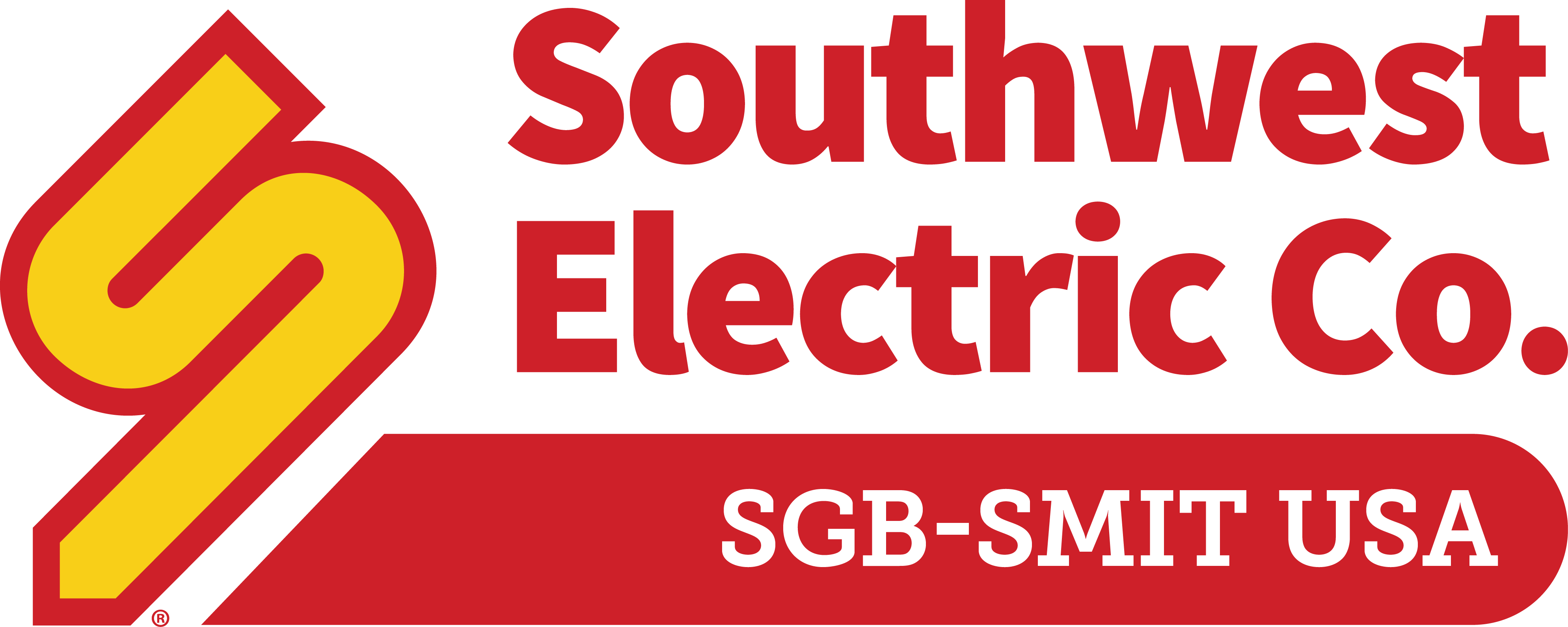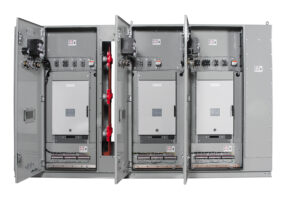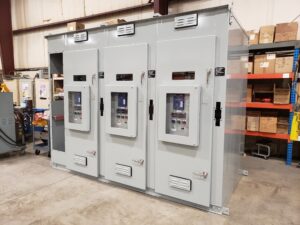By Eric Gersh, General Manager
Switchgear play a vital role in meeting the electrical demands of your facility. Its ability to control and protect electrical equipment is essential for the safe and reliable operation of any power system, whether in industrial, commercial, or utility environments. However, having switchgear is only part of the equation; selecting the right type for your specific operational needs is just as critical. In this blog, I’ll walk you through the different types of switchgear and key factors to consider during the selection process.
Understanding The Types of Switchgear:
The first step to choosing the right switchgear for your facility is to understand the different voltage levels, their typical applications, as well as the pros and cons of using them. Understanding the different types will provide you with the necessary toolset to determine which voltage range best suits your needs.
Low Voltage:
Generally, anything under 600 VAC is considered low voltage. In some standards, the low-voltage range can extend to 1,000 VAC, but 600 VAC and below are most common. Low voltage is used across all industries, including residential, commercial, and industrial applications. Below, I have broken down the voltage by application.
- Residential: Operate at 120/240 VAC.
- Commercial/Industrial: 208 – 575 VAC (depending on equipment & application)
The benefits of using low-voltage switchgear in your lineup are that it is simply safer to work with compared to medium and high-voltage switchgear. Additionally, they are more widely supported, with readily available equipment and components. This allows for greater flexibility due to their use in a wide range of applications.
On the other hand, some of the drawbacks to low voltage are that it is not suitable for high-power transmission or large industrial equipment. A higher current would be required to transmit the same power as higher-voltage systems. This would require larger conductors, ultimately resulting in power loss over greater distances.
Medium Voltage:
Medium Voltage (MV) typically ranges from 1,000V (1kV) to 38,000V (38kV) and is primarily used in industrial, commercial, and utility applications. It’s most common in manufacturing plants, large commercial buildings, data centers, and electrical distribution networks.
The benefits of MV switchgear is that its higher voltage means lower current for the same power which reduces energy loss. In addition, it provides for more efficient power transmission over long distance as well as support for higher capacity equipment.
The drawbacks include higher upfront costs due to more complex equipment, as well as the need for additional space to accommodate larger switchgear. Increased system complexity also brings stricter safety protocols and more demanding maintenance requirements.
High Voltage:
High Voltage (HV) typically refers to voltages above 38,000V (38kv) and is used in utility transmission and distribution systems that facilitate long-distance power transmission. In transmission contexts, the equipment can range from 69kV to 230kv, and in extremely high voltage cases, it can range as high as 765kv or more making them unsuitable for other applications.
The benefits of using HV switchgear is that it enables efficient long-distance transmission of electrical power by reducing current levels, which minimizes line losses, allows for smaller conductors, and supports large-scale power distribution infrastructure.
The downsides include the need for specialized, high-cost equipment, increased safety risks, and the fact that high-voltage systems are not suitable for direct end-user applications.
Factors to Consider When Choosing Switchgear:
Because of their critical role in power distribution, it’s essential to consider several key factors when selecting your gear. Below, I’ve outlined some of the most important considerations to guide you through the selection process.
Voltage Levels & Load Requirements:
Understanding your facility’s voltage levels and load requirements is essential when selecting switchgear. The gear’s voltage rating must align with the incoming system voltage from the utility. Therefore, when requesting new or replacement switchgear, it’s important to conduct a thorough analysis of both current and anticipated load demands. This should include a short circuit analysis and an Arc Flash study. The data gathered from these assessments will help determine the appropriate size and rating of the switchgear required.
Environmental & Installation Conditions:
The environment in which your equipment will be installed plays a critical role in its long-term performance and durability. Switchgear is available in various NEMA classifications, each designed for specific environmental conditions. For instance, indoor applications typically require NEMA 1 or NEMA 12 enclosures, while outdoor installations commonly use NEMA 3R or NEMA 4. Understanding and familiarizing yourself with these classifications is essential to ensure your gear can withstand the environmental challenges it will face.
Beyond selecting the appropriate NEMA classification for your switchgear, it’s important to account for additional environmental conditions such as climate, humidity, dust, and corrosive materials. Hot environments may require supplemental ventilation or cooling fans, while cold climates may necessitate internal heating elements. In areas with high humidity or moisture, preventative measures should be taken to avoid condensation on internal metal components. Similarly, locations with excessive dust or airborne particles should include filtration systems capable of capturing fine particulates. Considering these factors is essential to ensure your equipment performs reliably and has a long operational life.
Safety & Compliance Standards:
Switchgear is designed to meet key national and international safety standards, including those set by ANSI, IEC, OSHA, and NFPA. These standards regulate critical aspects such as performance, safety, and installation requirements.
In addition to compliance with these codes, it’s important to understand the built-in safety features of your switchgear and evaluate whether additional protective measures are needed. Modern switchgear can incorporate a wide range of integrated safety features—such as arc flash mitigation, interlocks, and specialized insulation—based on your specific application needs and budget. A few of these features include:
- Arc flash mitigation systems: arc-resistant construction, fast-acting relays, arc flash detection, etc.
- Mechanical & electrical Interlocks: help prevent unsafe operations
- Insulation & compartmentalization: isolates live components
- Protective relaying: tailored for motors, transformers, feeders, and other system components
Maintenance & Operational Flexibility:
Modern switchgear requires regular maintenance to ensure reliability and safety. NEMA provides detailed maintenance guidelines that outline recommended tasks based on factors such as location, environmental conditions, and the criticality of the equipment. Easy access to spare parts and serviceability should also be considered during the selection process.
Many switchgear systems can be designed for future expansion, provided the manufacturer is informed prior to production. Modular designs allow for easier upgrades and configuration changes. Additionally, remote monitoring capabilities are increasingly available, enabling real-time diagnostics, status checks, and predictive maintenance—all of which improve uptime and system performance.
Budget & Lifecycle Costs:
Budgeting for switchgear largely depends on the specific needs of your application. For example, a basic fused load break switch is typically the most cost-effective option, offering minimal
but sufficient protection for certain systems. As system complexity, size, and required capabilities increase, so does the associated cost.
When evaluating lifecycle costs, it’s important to consider ongoing maintenance and the overall health of the system the switchgear is integrated with. Even the highest-quality switchgear can underperform or wear out prematurely if it’s connected to unreliable or poorly maintained equipment. Additionally, most switchgear is rated for a defined number of fault events or operating cycles before components require inspection or replacement. Proper care and routine maintenance play a critical role in maximizing the lifespan and cost efficiency of the equipment.
Choosing the Right Partner or Vendor:
As with any major equipment investment, you get what you pay for—and switchgear is no exception. These are critical, high-value components that play a central role in safety and protection. While it may be tempting to reduce costs upfront, choosing low-quality or budget-grade equipment can result in significant risks, including unscheduled downtime, equipment failure, or even safety hazards.
Switchgear must reliably perform multiple functions—protection, switching, metering, and control—which demands high-quality components and thoughtful engineering. Equally important is the ongoing support and partnership you receive from your equipment provider. Having access to your vendor for questions about replacement parts, expansion, documentation, or future upgrades is essential for long-term reliability and success.
At Southwest Electric Co., we not only supply high-quality, customizable switchgear solutions—we also stand behind our equipment with expert support, responsive service, and a commitment to long-term relationships. Whether you’re planning for today or the future, we’re here to ensure your power system runs safely, efficiently, and reliably.
Conclusion:
Choosing the right switchgear is more than just matching specifications—it’s about ensuring the long-term safety, reliability, and efficiency of your entire electrical system. By understanding the different voltage classes, evaluating your facility’s unique environmental and operational conditions, and factoring in maintenance, safety, and lifecycle costs, you can make an informed decision that supports both your immediate needs and future growth.
Equally important is selecting a trusted partner who not only delivers high-quality equipment but also provides ongoing support throughout the lifespan of your system. At Southwest Electric Co., we specialize in helping you navigate every step of the switchgear selection process—from design and customization to maintenance and expansion planning. With decades of experience, industry-leading service, and a commitment to reliability, we’re here to power your success.
Ready to choose the right switchgear for your facility? Contact Southwest Electric Co. today to get started




